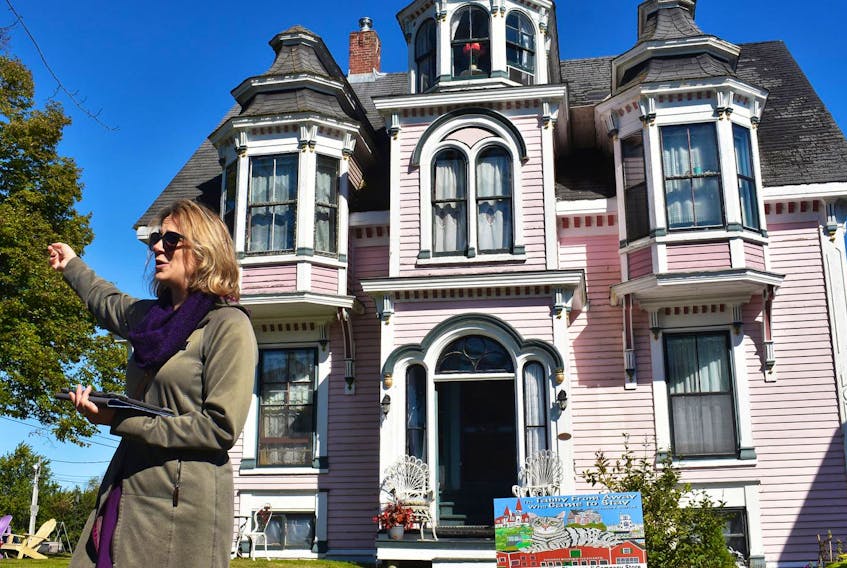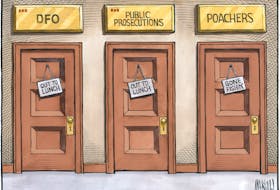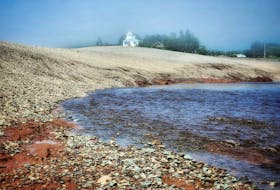Casting an eye at the reading list for Lunenburg Lit’s walking tour, held Sept. 28 to 29 in Lunenburg, it would appear the town was built on books. And it is a mighty compilation spanning decades. As guide and eighth-generation Lunenburger Ashlee Feener explained, the town’s history lends itself to storytelling.
“I think that the landscape is attractive to any artisan, to any author, any writer,” said Feener, the co-owner of Lunenburg Walking Tours.
“The impressive architecture, the colourful houses, the bright skies, the blue harbour ... it’s hard not to be inspired when you’re here.”
But Lunenburg’s history, and the books written about it, aren’t all bright like the buildings lining King Street.
There are books chronicling the years of rum running and law breaking, the storms that gutted the fishing fleet and countless others going back until the town’s founding in 1753. This treasure-trove of literary accounts, explained South Shore Public Libraries CEO Troy Myers, comes as a result of the town’s dedication to preserving — and sharing — its history.
“It doesn’t take much imagination to picture days gone by because the town has done an excellent job preserving its past as it looks for its future,” he said.
And as a part of the third annual Lunenburg Literary Festival, all of these stories—the good, the bad and the salty—were within walking distance.
The walking group met atop Gallows Hill and stood in the parking lot of the newly renovated Lunenburg Academy, taking in the historic view and clear autumn morning. Feener started by recounting that the view would have been very similar to the one the British encountered 265 years previous when they first made their way to the South Shore, minus some trees.
“The story here is really just a continuation of the story of Halifax,” she said.
The history of those first years, explained Feener, is well encapsulated in Winthrop Pickard Bell’s book—the first on the reading list: The Foreign Protestants and the Settlement of Nova Scotia. The first British settlers were mostly recruited Protestants from southwestern Germany as well as from the Montbéliard districts of France and Switzerland.
And their lot in life, said Feener, was decided by a card lottery which determined which plot of land they would get in Lunenburg’s iconic grid pattern.
Other books, like Eric Wilson’s The Ghost of Lunenburg Manor, allows young readers to inhabit spaces like the Lunenburg Academy through a writer’s eyes. Feener said being able to showcase Wilson’s setting to readers is a treat.
“For me, the best part about this is there are a number of curriculums that cover this book. Eric will come and do lectures for the classes,” she said.
“And then they come to Lunenburg to tour the sites from the book. It’s fantastic.”
From Gallows Hill, the tour rolled after Feener into town via York Street and slowly ambled along the UNESCO-designated sites.
Feener noted that the houses and buildings, painted in their bold reds and gaudy yellows, still follow the original grid pattern established by the first British settlers.
This makes the town particularly interesting to historians and architects like author Bill Plaskett, who chronicled every building in Lunenburg in an attempt to document and place them in architectural history. His impressions are available in the work Understanding Lunenburg’s Architecture.
Tumbling toward the water, Feener’s account fast forwarded toward another chapter of Lunenburg’s history: Rum running.
“There’s some great books about rum running,” she said. “We realized if we could start running rum, running booze, we could make some money doing it.”
And according to Feener, the most famous of Lunenburg’s runners was Hugh Corkum, who chronicled his experiences in his autobiography, On Both Sides of the Law.
Corkum quit school at 15 and committed himself to a life at sea. He quickly became a smuggler and was arrested three times.
In a twist of fate, he later became Lunenburg’s chief of police.
“Which is why we celebrate him and how he behaved on both sides of the law,” explained Feener with a laugh.
The final stop of the literary tour was the Fishermen’s Memorial.
Here Feener talked about the importance of Lunenburg’s fishing history and the the cost of that legacy; the names of those lost at sea, etched into stone, echoed her words.
Gerald Hallowell’s The August Gales, said Feener, is one of the premier reads of what it would have been like for the men working at sea during the 1920s and 1930s.
“It really does capture the settlement of the town, the tragic loss of fishing schooners, that’s the story,” she said.
And from the start of the tour at the Academy down to the Fishermen’s Memorial, Feener shared a lot of the town’s stories. The art of storytelling is something she relishes.
“Day to day, I’m so lucky to lead people through the town showcasing the architecture, sharing stories of the history, directing people on what not to miss while they’re here,” she said.
“It’s just so fun to celebrate the way Lunenburg’s been captured through books, through film, through TV.”
And throughout the Lunenburg Literary Festival weekend in September, the town was filled to gunwales with authors celebrating literature from across the country.
For his part, Myers said people can’t help but come and be inspired by Lunenburg.
“I believe people want to capture their impressions of our little town because of the fact it has such a rich history and unique architecture that is still very evident as folks wander the storied streets of Lunenburg.”
Here is the recommended reading list for the Lunenburg Literary Festival’s walking tour:
Bell, Dr. Winthrop Pickard, The Foreign Protestants and the Settlement of Nova Scotia, 1961.
Bradford, Jim, The Tabby From Away Who Came to Stay, 2013.
Corkum, Hugh, On Both Sides of the Law, 1989.
Creighton, Helen, Folklore of Lunenburg County, 1976.
Hallowell, Gerald, The August Gales: The Tragic Loss of Fishing Schooners in the North Atlantic, 1926 and 1927, 2013.
Halsey, Jacqueline, Bluenose Adventure, 2013.
James, Terry and Bill Plaskett, Buildings of Old Lunenburg, 2011.
Pardy, Laurel, A Lady of Lunenburg, 2010.
Plaskett, Bill, Understanding Lunenburg’s Architecture, 1989.
De Villiers, Marq, Witch of the Wind: The True Story of the Legendary Bluenose, 2007.
Wilson, Eric, The Ghost of Lunenburg Manor, 1981.









